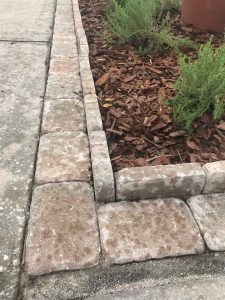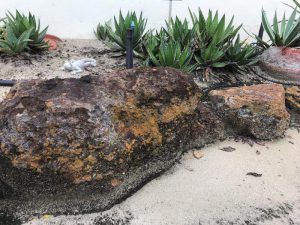Landscape edging is often an afterthought when it comes to home lawns and landscapes, but it’s one of those details that can really make a front yard stand out. Use edging to define garden rooms, outline a space and keep groundcovers, plants, and mulch in bounds. Edging also creates a neat, tidy look which is important for property values as it makes a home yard look manicured. Depending on the materials used, landscape edging can even be a decorative feature. The styles are endless and pricing options vary greatly.
Fairly easy to install, edging can be set by even the novice landscaper or gardener. Like most home improvement projects, there is a significant amount of prep work involved. Pulling out weeds, plants, or turf, and removing existing mulch or edging materials will increase your heartrate and rack up calories burned on your fitness tracker. Let’s explore some of the options.
Black Plastic Edging

Functional and relatively inexpensive, black plastic edging is readily available at most retail garden centers. It’s easy to use and can be installed the very day it’s purchased. Mold it into shape and secure it with long plastic landscape stakes. If metal landscape stakes are available, consider splurging as the metal offers more bite, making it harder to pull out of sandy soils. Place and secure the edging to the outside of your landscape bed, add your plants and lastly, mulch.
Typically, black plastic edging will not last long-term, but you should be able to get several years out of it before replacement is needed. Plastic exposed to full sun will break down faster than plastic protected by shade. Keep these site conditions in mind when considering the longevity of edging materials.
Pavers as Edging
For a longer lasting edging material, consider pavers. Found in multiple colors, shapes, and sizes, pavers add a polished look and formal feel to the landscape. This decorative brick or concrete material requires a little more know how and a lot more manpower to install it correctly. But a beautiful, durable edge will be a lasting result.

To edge with pavers, dig out about a six-inch trench around the outside of the landscape bed. Tamp the soil until firm and footprints are barely noticeable when walked upon. Add a two to four-inch layer of paver sand and tamp again. Next, hammer the pavers in place on top of the sand with a rubber mallet. Meanwhile, use a level to adjust the pavers against surfaces such as sidewalks and driveways. An important step, leveling produces an even walking surface to prevent trip hazards.

Once satisfied with the paver edging, use a polymeric sand in between paver crevices, but only use polymeric sand when conditions are completely dry. Excess polymeric sand must be removed as it could bind to the top of the pavers, damaging the aesthetic. Now that I’ve installed my first batch of pavers, I’m ready to “paver” everything. But I must leave the big jobs, like driveways and high traffic sidewalks, to the professionals.
Find out more about creating sidewalks and walkways here https://gardeningsolutions.ifas.ufl.edu/design/outdoor-living/walkways.html.
Natural Materials

Last, but certainly not least, take a cue from nature as rocks, stones, or even fallen tree branches could serve as an edging material for landscape beds. These naturalistic landscape materials would fit nicely in a forested yard, meadow or even in a front yard containing wildflowers and native plants. At UF/IFAS Extension, Lake County’s Discovery Gardens, medium sized limestone rocks edge the landscape bed of the Southwest garden. Landscape edging options are endless and are only limited by your creativity. Use edging to add a distinct look to your home yard.
To learn more about Florida-Friendly Landscaping visit https://ffl.ifas.ufl.edu/.
 0
0
